Right off the top — if you don’t love olives, quickly close this page and move on to something you prefer. Sorry. This one’s not for you.
On the other hand, if you love olives….read on!
During any of the entertaining seasons of the year, it’s a challenge to keep just the right snack on hand. Oh, I have good intentions. I lay in crackers, nuts, make my own pita chips, even certain favorite dips, but if any time passes between the day I stock up and the arrival of unexpected guests, somehow, mysteriously, there’s nothing left in my cupboards. I wonder how that happens?
Tapenade is a multi-tasker of infinite variety that never fails to impress. If you run into some old friends in the grocery store and ask them over on a whim, you can just swing by the olive bar for ingredients and a baguette, nip home, whip up some tapenade, and still have time to put on your lipstick before they arrive. It’s perfect on fresh baguette slices with a beer or a glass of wine, in the late afternoon on the deck when you’re deciding whether it’s too hot to eat real food. Spread some on a flour tortilla, top with cheese, bake at 400°F for a few minutes, cut in wedges, and you have a terrific hot hors d’oeuvre in the cooler months. If you invited quite a few people, layer tapenade thickly on a small whole Brie, bake until the cheese is soft, and serve with crackers. If you made a spontaneous dinner invitation, pick up some salmon, spread it with tapenade, and cook it on the barbeque – you’re a star! Try it on a burger, with feta cheese. Grilled cheese and tapenade sandwiches — yum. Your imagination is the only limiting factor.
Never heard of it? Tapenade is a rough paste of olives, capers, anchovy and garlic, smoothed out with olive oil. You can get it ready-made at the deli counter, but what’s the fun in that? If you make your own, your credibility as a fine cook increases immeasurably. Tapenade is a Mediterranean thing. A little Googling reveals that it was named for the capers, an essential ingredient, which in ancient times were stored in large quantities in olive oil, rather than in brine as we get them now. Over time the capers would squash down into the bottom of the storage jar and form a tasty paste. Much time has passed since then, and olives have taken over the starring role.
I can hear somebody saying “ick, ick, ick … anchovies”. Stop that. Anchovies are one of the best flavor boosters around, a primo source of “umami”. A little goes a long way. Tapenade doesn’t taste fishy – it tastes GOOD. I would suggest you buy anchovies in paste form, rather than in the tin. It’s easy to squeeze out an inch or so of paste, compared to draining, rinsing, and chopping tinned anchovies. You often only need one or two fishies at a time (for something like Ceasar salad or putanesca sauce, for instance). Frozen leftover anchovies, in their tiny plastic bag, tend to slide to the very bottom of the freezer where they are lost forever. Anchovy paste can live in your refrigerator door, encouraging you to use this wonderful, versatile ingredient more often.
A food processor is the fastest and easiest tool for making tapenade, but you can chop up a small batch right on your cutting board, or use that mortar and pestle you bought on a whim because it looked so neat when Jamie Oliver used it on TV.
Let’s get started.

Tapenade
Ingredients
This is a suggestion for basic tapenade. Many suggestions for variations will be given just down the page a bit.
1 cup pitted olives – rinsed and drained.
1 tsp anchovy paste (or perhaps 2 tinned anchovies,rinsed, dried, chopped)
1 clove garlic, pureed.
1 Tbsp capers, rinsed and drained
1/2 tsp lemon zest and 1 tsp lemon juice
1 Tbsp olive oil (approximately)
1 tsp Dijon mustard

Rinsing the salty ingredients is important to the finished flavor of the tapenade – don’t leave this part out. That means the olives, the capers, and the anchovies if you aren’t using paste. Anything extra that came in brine needs a rinse. Anything that came packed in oil you can probably leave as is.


A word or two about fresh garlic. If your garlic has sprouted, but there is still enough “clove” around the sprout to use, just remove the sprout and carry on. If, on the other hand, there is more sprout than clove, off to the compost it goes. If the grocery store is closed, you can substitute granulated or powdered garlic (NOT garlic salt), but know that you’re going to have to wait a bit for it to rehydrate before the flavor stabilizes, and it’s NOT going to taste the same as fresh. Use about 1/8 teaspoon of granulated garlic per clove. If your garlic powder bottle is dusty and you can’t remember when you bought it, it’s not going to be an ideal contributor. There are better back-up plans for sudden lack of fresh garlic. Garlic in a squeeze tube is easy to keep on hand. Frozen pureed garlic, your own or a commercial product, are also useful. Neither of them last forever either, though – keep track of “best before” dates. If you’re not the sort of person who is likely to make your own pureed garlic to store in the freezer (I know who you are) you can freeze peeled or unpeeled whole garlic cloves with good success. You could make a habit of freezing your leftover cloves in a little container instead of leaving them to languish in the crisper, where they will surely take on a life of their own.
Here’s how you can get the pit out of an olive without an olive pitter. Just crush the olive firmly under your French knife, or a small pot or skillet, and then pop the pit out with your thumb.




Method:
Food Processor Method: It doesn’t get any easier than this. In the smallest work bowl, process everything until the paste is as smooth as you want it. The mustard allows emulsification (fancy word for mixing together) of the oily ingredients and the watery ingredients, so they won’t separate into layers later on.


Mortar and Pestle Method: Chop everything coarsely, then grind and/or pound to the desired texture. I don’t own a mortar and pestle, because, although I admire Jamie Oliver, I don’t buy his stuff.
Cutting board Method: Chop the olives as finely as you want to. Add everything else except the olive oil and mustard and chop the ingredients together to mix. Scrape the olive mixture into a bowl and stir in the mustard, lemon juice and olive oil by hand, quite vigorously so the mustard can do its emulsification thing.


It’s nice if you can let the tapenade rest for a while before eating it – it gives the ingredients time to get to know each other, and particularly mellows out raw garlic. Leftovers can be stored in an airtight container in the refrigerator for quite a long time – pretty much everything is pickled in the first place, and pickling is an age old method of preservation. Traditionally, a thin layer of olive oil is poured over the surface to seal the ingredients – my tapenade never lasts long enough to need this kind of loving attention. And yes, you can freeze it.

OPTIONS:
If fish is not your friend, for reasons either physical or philosophical, you can just leave the anchovy out entirely and enjoy the flavor of the olives. In some kinds of oriental dishes, we might add soy sauce where the anchovies were — I have never tried this with tapenade, because I love anchovies.
I keep capers on hand all the time. I like them in egg salad, and they are essential in tartar sauce, which I prefer to whip up in tiny batches rather than keeping a whole jar on hand.
This basic tapenade recipe is just a guideline. If you visit the olive bar at your local grocery store to get the olives, you could also pop in a bit of roasted red pepper, maybe a sundried tomato, an artichoke heart or two. The tapenade police won’t show up at your door if you decide to freestyle.
Some folks like to add a generous amount of freshly ground black pepper to their tapenade, which adds to the bite of fresh garlic. The addition of fresh green herbs is lovely, if you have them on hand – thyme, parsley, basil, oregano, rosemary, chives – it’s all good. In a small batch, don’t overdo the strong ones (I’m thinking about the rosemary and fresh oregano in particular).
I understand that pine nuts can be ground into the paste for variety, and there are recipes that include figs and walnuts for that sweet/savory flavor. Feel free to add a little more or less of the lesser ingredients (lemon, olive oil, capers, mustard) – just keep the olives in the forefront. I personally like to finish my tapenade with a tablespoon of soft butter instead of the olive oil – it really smooths out the flavor.
The better the olives, the better the tapenade. You can use regular old canned pitted black olives, but you’ll get regular old canned pitted black olive flavor. Now that olive bars seem to be everywhere, take advantage of the variety! Nicoise olives are a classic, but sometimes you want a black/green combination, just because. All green works too.
So make a little, or make a lot. Make it on the spot, or keep it in the freezer. Either way, you have a custom-made multi-tasker at your beck and call for spontaneous entertaining in any season.






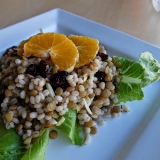
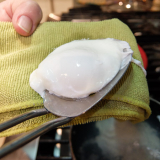
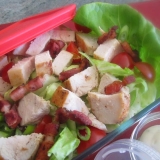

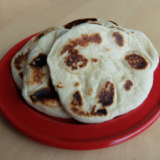

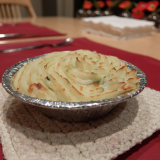


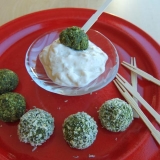

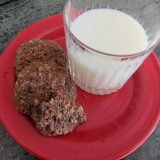

Leave A Comment